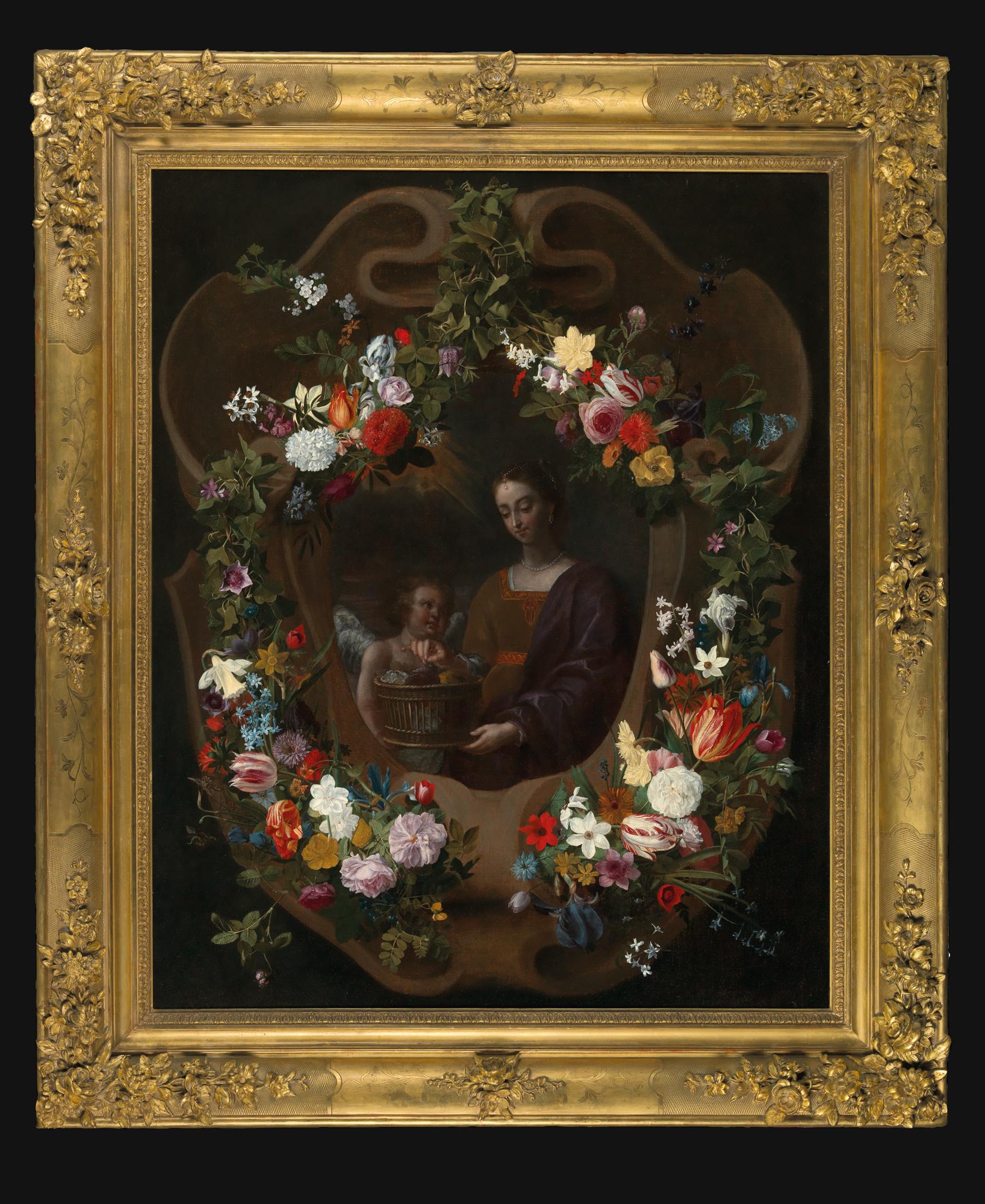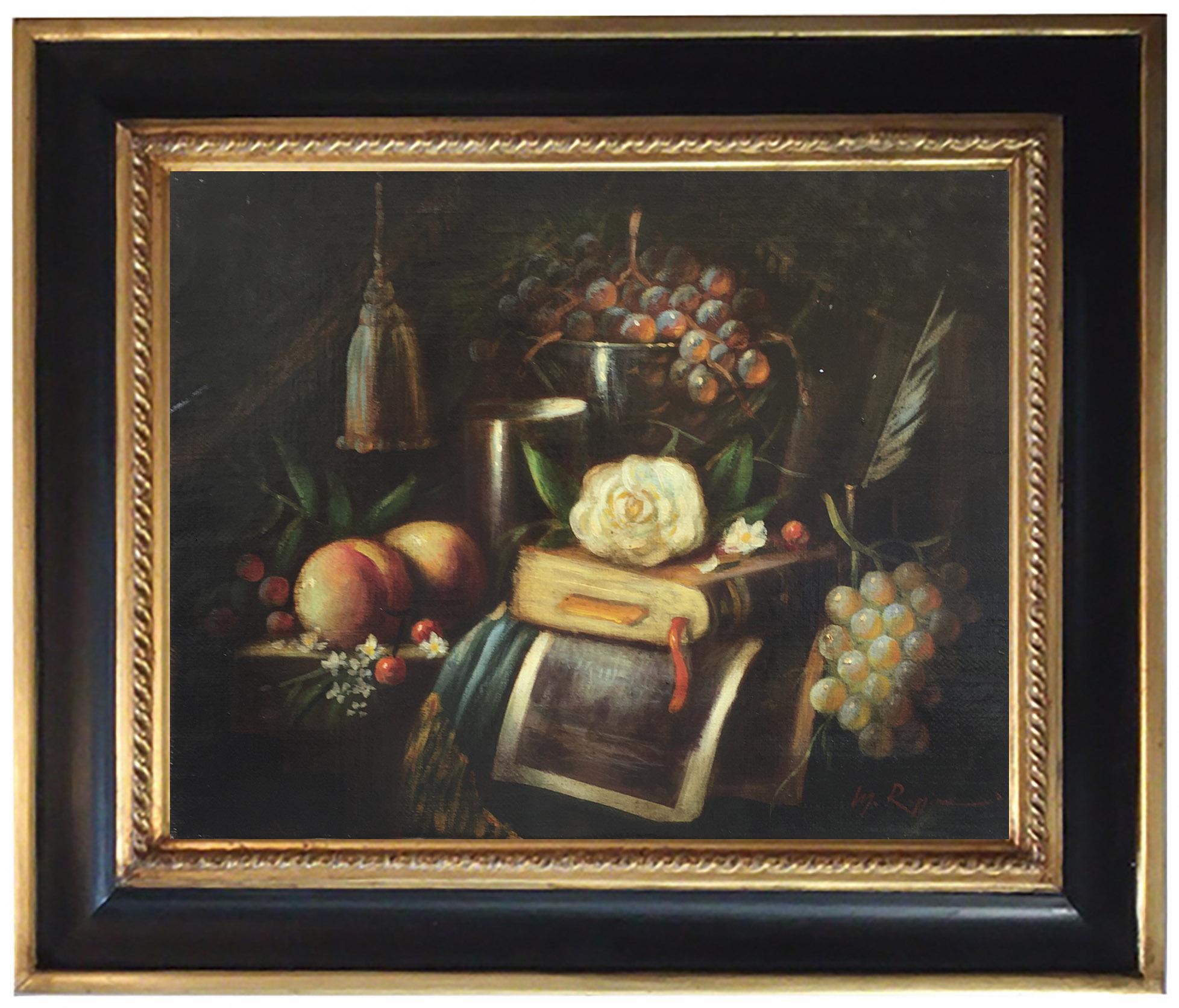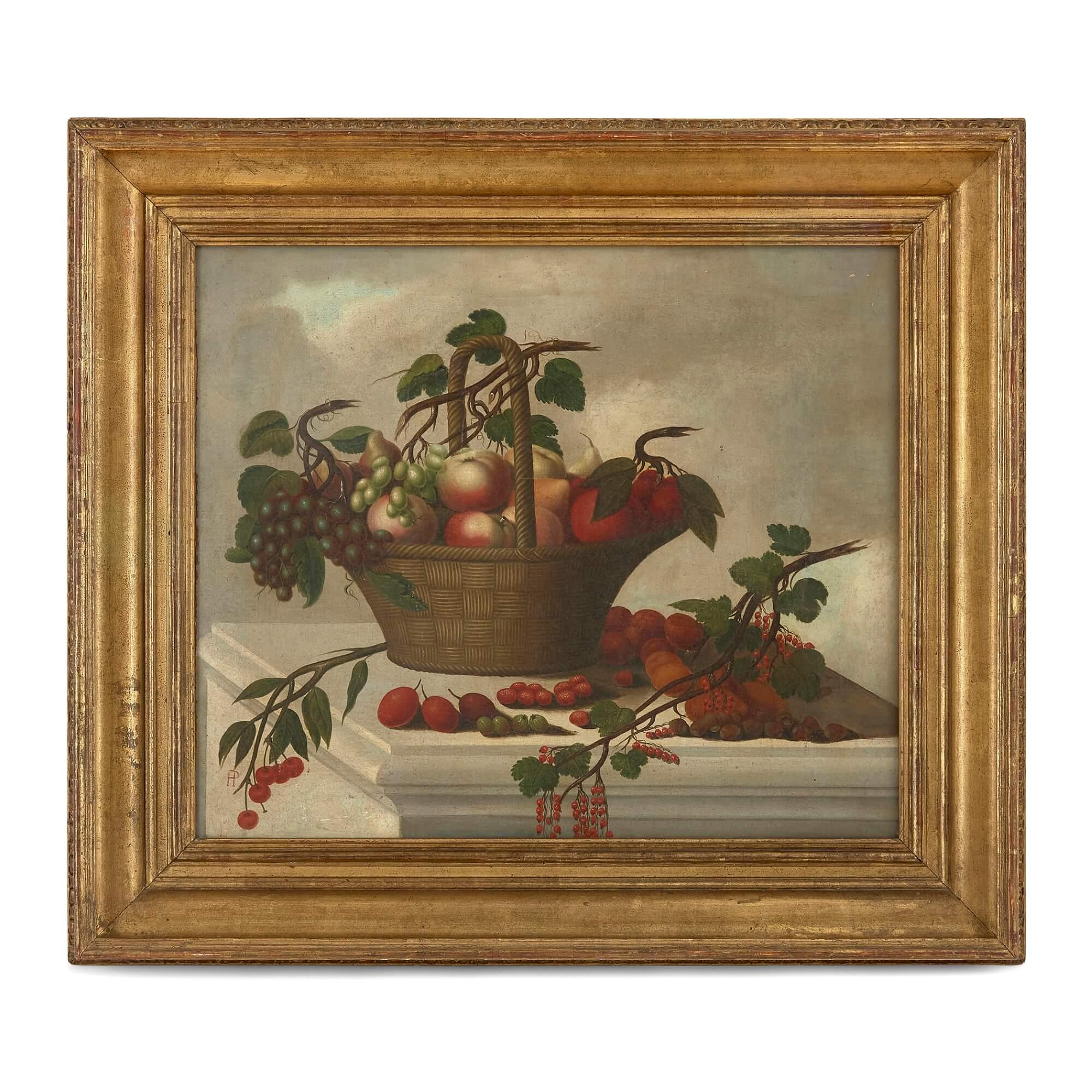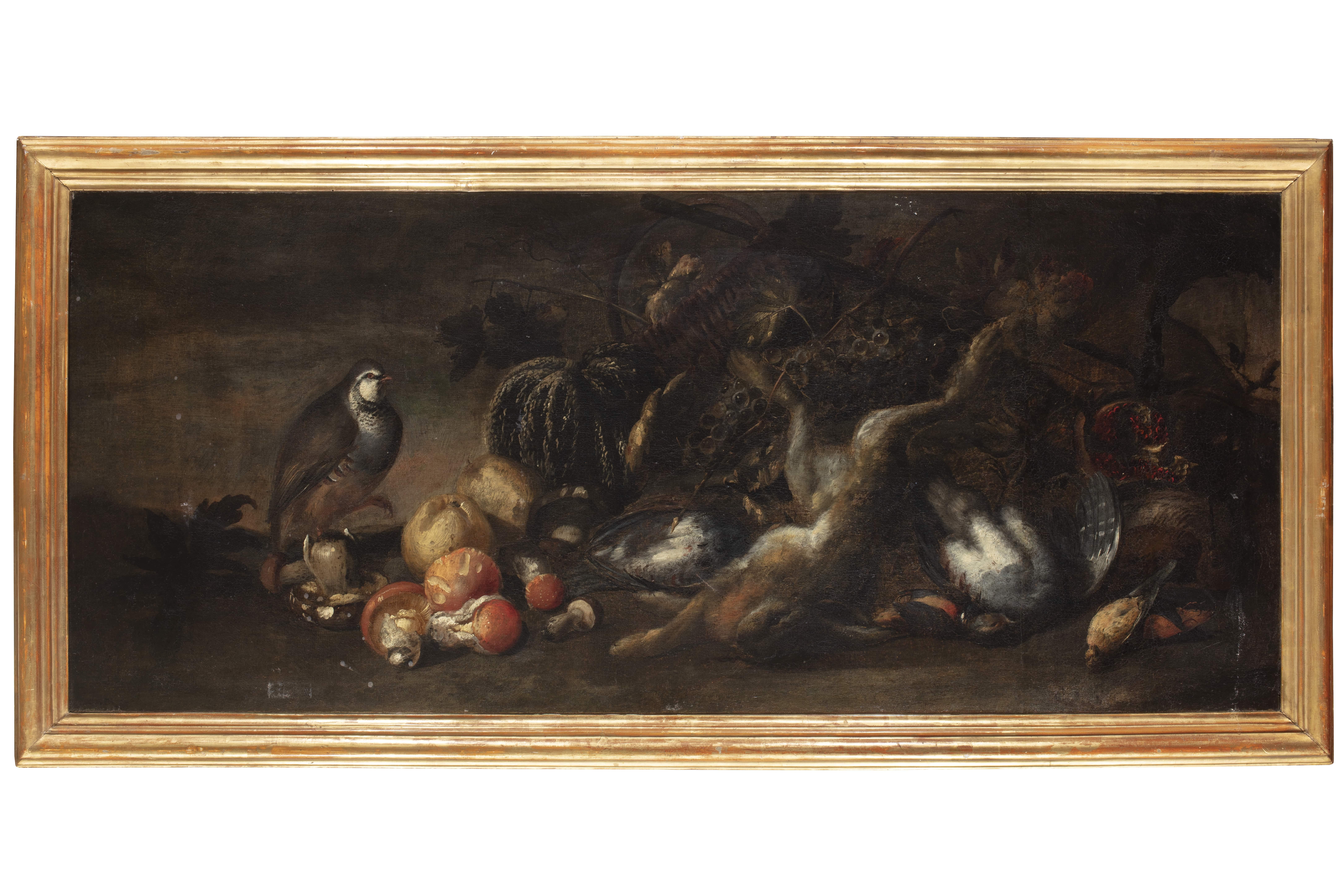Items Similar to Still Life with Squash, Gourds, Stoneware, and a Basket with Fruit and Cheese
Want more images or videos?
Request additional images or videos from the seller
1 of 5
Still Life with Squash, Gourds, Stoneware, and a Basket with Fruit and Cheese
About the Item
Provenance:
Selma Herringman, New York, ca. 1955-2013; thence by descent to:
Private Collection, New York, 2013-2020
This seventeenth century Spanish still-life of a laden table, known as a bodegón, stands out for its dramatic lighting and for the detailed description of each object. The artist’s confident use of chiaroscuro enables the sliced-open squash in the left foreground to appear as if emerging out of the darkness and projecting towards the viewer. The light source emanates from the upper left, illuminating the array, and its strength is made apparent by the reflections on the pitcher, pot, and the fruit in the basket. Visible brush strokes accentuate the vegetables’ rough surfaces and delicate interiors. Although the painter of this striking work remains unknown, it is a characteristic example of the pioneering Spanish still-lifes of the baroque period, which brought inanimate objects alive on canvas.
In our painting, the knife and the large yellow squash boldly protrude off the table. Balancing objects on the edge of a table was a clever way for still-life painters to emphasize the three-dimensionality of the objects depicted, as well a way to lend a sense of drama to an otherwise static image. The knife here teeters on the edge, appearing as if it might fall off the table and out of the painting at any moment. The shape and consistency of the squash at left is brilliantly conveyed through the light brush strokes that define the vegetable’s fleshy and feathery interior. The smaller gourds—gathered together in a pile—are shrouded partly in darkness and stand out for their rugged, bumpy exterior. The stoneware has a brassy glaze, and the earthy tones of the vessels are carefully modulated by their interaction with the light and shadow that falls across them. The artist has cleverly arranged the still-life in a V-shaped composition, with a triangular slice of cheese standing upright, serving as its pinnacle.
Independent still-lifes only became an important pictorial genre in the first years of the seventeenth century. In Italy, and particularly through the revolutionary works of Caravaggio, painted objects became carriers of meaning, and their depiction and arrangement the province of serious artistic scrutiny. Caravaggio famously asserted that it was equally difficult to paint a still-life as it was to paint figures, and the elevation of this new art form would have profound consequences to the present day. In Spain Juan Sanchez Cotan, almost an exact contemporary of Caravaggio, inaugurated the distinctive tradition of Spanish still-life painting with memorable images of common vegetables and fruits depicted with reverence and elegance. His Quince, Cabbage, Melon and Cucumber (Fig. 1) both illustrates the origins of this tradition and provides a useful comparison to the present work. The objects—conventionally thought of as unremarkable, if not ugly—are depicted in painstaking detail against a dark background. They are arranged in a parabolic composition, with the quince and leafy cabbage suspended in the air on strings, while the slice of freshly cut melon and the cucumber jut out beyond the ledge. The varied shapes and textures so meticulously recorded contrast with the harsh geometrical surround of the window and the uniform black background, giving these objects a new-found importance and beauty.
The author of our painting is not known. Although there are compositional echoes of the works of such artists as Blas de Ledesma and Alejandro de Loarte, the style of our painting is not sufficiently distinctive to permit its association with any known painter. But it is clearly a work of the period, one characterized by what seems a charming naiveté in its frank and objective representation of the objects depicted.
In our painting the anonymous artist has chosen especially humble subjects. The gourds are common, and the ceramic pitcher and crock unadorned and utilitarian. The basket, fruit, and cheese are those of the laborer, not the prince. These are not the luxury possessions one will find in Dutch still-lifes later in the century, included to reflect the wealth and sophistication of their owners. Rather here, with the depiction of modest objects on a bare table, the artist extols both the significance and beauty of the everyday, as he subtly celebrates the humility of their owner.
- Dimensions:Height: 20.5 in (52.07 cm)Width: 24.5 in (62.23 cm)
- Medium:
- Movement & Style:
- Circle Of:Juan Sanchez Cotan (1560 - 1627, Spanish)
- Period:
- Condition:
- Gallery Location:New York, NY
- Reference Number:1stDibs: LU1027909252

About the Seller
5.0
Recognized Seller
These prestigious sellers are industry leaders and represent the highest echelon for item quality and design.
Established in 1997
1stDibs seller since 2012
17 sales on 1stDibs
- ShippingRetrieving quote...Ships From: New York, NY
- Return PolicyThis item cannot be returned.
More From This SellerView All
- Julius Caesar on HorsebackBy Antonio TempestaLocated in New York, NYProvenance: Private Collection, South America Antonio Tempesta began his career in Florence, working on the decoration of the Palazzo Vecchio under the direction of Giorgio Vasari. He was a pupil first of Santi di Tito...Category
16th Century Old Masters Paintings
MaterialsOil, Canvas
- Job Cursed by His WifeBy Giovanni Battista LangettiLocated in New York, NYProvenance: Alfred (1883-1961) and Hermine Stiassni (1889-1962), Brno, Czech Republic, by 1925; thence London, 1938-1940; thence Los Angeles, 1940-1962; thence by descent to: Susanne Stiassni Martin and Leonard Martin, San Francisco, until 2005; thence by descent to: Private Collection, California Exhibited: Künstlerhaus, Brünn (Brno), 1925, as by Ribera. “Art of Collecting,” Flint Institute of Art, Flint, Michigan, 23 November 2018 – 6 January 2019. Literature: Alte Meister...Category
1670s Old Masters Paintings
MaterialsCanvas, Oil
- Portrait of a GentlemanLocated in New York, NYCircle of Jacques-Louis David (French, 18th Century) Provenance: Private Collection, Buenos Aires Exhibited: “Art of Collecting,” Flint Institute of Art, Flint, Michigan, 23 November 2018 – 6 January 2019. This vibrant portrait of young man was traditionally considered a work by Jacques-Louis David, whose style it recalls, but to whom it cannot be convincingly attributed. Rather, it would appear to be by a painter in his immediate following—an artist likely working in France in the first decade of the nineteenth century. Several names have been proposed as the portrait’s author: François Gérard, Louis Hersent, Anne-Louis Girodet (Fig. 1), Theodore Gericault, and Jean-Baptiste Wicar, among others. Some have thought the artist Italian, and have proposed Andrea Appiani, Gaspare Landi...Category
18th Century Old Masters Paintings
MaterialsCanvas, Oil
- Portrait of a Lady with a ChiqueadorLocated in New York, NYProvenance: Torres Family Collection, Asunción, Paraguay, ca. 1967-2017 While the genre of portraiture flourished in the New World, very few examples of early Spanish colonial portraits have survived to the present day. This remarkable painting is a rare example of female portraiture, depicting a member of the highest echelons of society in Cuzco during the last quarter of the 17th century. Its most distinctive feature is the false beauty mark (called a chiqueador) that the sitter wears on her left temple. Chiqueadores served both a cosmetic and medicinal function. In addition to beautifying their wearers, these silk or velvet pouches often contained medicinal herbs thought to cure headaches. This painting depicts an unidentified lady from the Creole elite in Cuzco. Her formal posture and black costume are both typical of the established conventions of period portraiture and in line with the severe fashion of the Spanish court under the reign of Charles II, which remained current until the 18th century. She is shown in three-quarter profile, her long braids tied with soft pink bows and decorated with quatrefoil flowers, likely made of silver. Her facial features are idealized and rendered with great subtly, particularly in the rosy cheeks. While this portrait lacks the conventional coat of arms or cartouche that identifies the sitter, her high status is made clear by the wealth of jewels and luxury materials present in the painting. She is placed in an interior, set off against the red velvet curtain tied in the middle with a knot on her right, and the table covered with gold-trimmed red velvet cloth at the left. The sitter wears a four-tier pearl necklace with a knot in the center with matching three-tiered pearl bracelets and a cross-shaped earing with three increasingly large pearls. She also has several gold and silver rings on both hands—one holds a pair of silver gloves with red lining and the other is posed on a golden metal box, possibly a jewelry box. The materials of her costume are also of the highest quality, particularly the white lace trim of her wide neckline and circular cuffs. The historical moment in which this painting was produced was particularly rich in commissions of this kind. Following his arrival in Cuzco from Spain in the early 1670’s, bishop Manuel de Mollinedo y Angulo actively promoted the emergence of a distinctive regional school of painting in the city. Additionally, with the increase of wealth and economic prosperity in the New World, portraits quickly became a way for the growing elite class to celebrate their place in society and to preserve their memory. Portraits like this one would have been prominently displayed in a family’s home, perhaps in a dynastic portrait gallery. We are grateful to Professor Luis Eduardo Wuffarden for his assistance cataloguing this painting on the basis of high-resolution images. He has written that “the sober palette of the canvas, the quality of the pigments, the degree of aging, and the craquelure pattern on the painting layer confirm it to be an authentic and representative work of the Cuzco school of painting...Category
17th Century Old Masters Paintings
MaterialsCanvas, Oil
- A WolfLocated in New York, NYProvenance: The Marchesi Strozzi, Palazzo Strozzi, Florence Sale, Christie’s, London, May 20, 1993, lot 315, as by Carl Borromaus Andreas Ruthart...Category
17th Century Old Masters Animal Paintings
MaterialsPaper, Canvas, Oil
- Holy Family with the Infant St. John the BaptistLocated in New York, NYLubin Baugin (Pithiviers 1610 – 1663 Paris) Holy Family with the Infant Saint John the Baptist Oil on canvas 22 x 42 ¼ inches (55.9 x 107.3 cm) Provenance: Marcello and Carlo ...Category
17th Century Old Masters Figurative Paintings
MaterialsOil, Canvas
You May Also Like
- 18th Century by Francesco Lavagna Pair of Flower Vases Oil on CanvasLocated in Milano, Lombardia98 x 36 cm each without frame - 112 x 50 cm with frame Antique gilded and shaped wooden box frames Expertise by Prof. Giancarlo Sestieri This marvellous pair of flower vases has b...Category
Early 18th Century Old Masters Figurative Paintings
MaterialsCanvas, Oil
- Grand-Scale Old Master Garland Portrait, 17th Century, Signed & Dated, Rare workLocated in London, GBIndistinctly signed and dated In the first quarter of the 17th century a new form of flower painting was developed in Flemish painting, which, recreated by a large group of artists and workshops, would achieve considerable success throughout the century in much of Europe: the garland of flowers surrounding a central figure. Brueghel de Velurs was the initiator of this type of composition, however, it was his pupil, Daniel Seghers, who was the dominant figure in this specialised production and the creator of a prototype that would serve as a model for the numerous artists who followed in his wake. It seems undeniable that the artist of the present painting had seen the Garlands of Flowers Surrounding a Medallion Depicting the Triumph of Love by Daniel Seghers and Domenico Zampieri (now in the Musée du Louvre in Paris). In our painting, the present floral wreath encircles a carved cartouche within which sits Saint Dorothy of Caesarea and the attribute which often accompanies her in art, a basket of roses. The extremely delicate flowers have been rendered in meticulous detail, so that every species can be identified from exotic tulips to roses, irises and forget-me-nots; this obvious attention to naturalism is inherited from the Flemish manner. Each flower is so precise and refined that they are an individual study in their own right. The still-lifes are from the hand of Jan Anton van den Baren, with the central figures by another accomplished hand. Van den Baren’s arrangement of flowers would have delighted connoisseurs in both Flanders and in Vienna, where the impossibility of their all blooming at the same time of year would have been understood as a further statement of the wonder and beauty of the divine. Van den Baren worked first in Brussels, where he collaborated with Erasmus Quellinus II for the figures in his works, before moving with Archduke Leopold Wilhelm, his patron, to Vienna in 1656, where he instead worked with fellow Flemish émigré painter Nikolaus van Hoy. The iconography relates to an eighth century legend where she was presented a basket of roses by a child. In addition to the brilliance of his handling of still-lifes Van den Baren played an important art historical role as Director of Archduke Leopold Wilhelm’s Picture Gallery in Vienna, then one of the greatest collections in the world and the core of what was to become the present collection of the Kunsthistorisches Museum, Vienna. Van der Baren compiled an inventory of the collection in 1659, and his predecessor as Director of the Archduke’s Picture Gallery (when it was still housed in Flanders), David Teniers, depicted van der Baren (third from right) in his celebrated Archduke Leopold Willem in his gallery at Brussels, conserved at the Kunsthistorisches Museum. It is a shining example of the Flemish Baroque and is a very rare object indeed, considering there are only 14 paintings accepted as authentic works by this artist. We are grateful to Fred Meijer for confirming the attribution to Johannes Antonius van der Baren. A feature of this painting is its outstanding carved and gilded frame with a plethora of flowers and foliage. Titan Fine ArtCategory
17th Century Old Masters Portrait Paintings
MaterialsCanvas, Oil
- STILL LIFE - Massimo Reggiani - Oil on Canvas Italian PaintingBy Massimo ReggianiLocated in Napoli, ITSTILL LIFE - Oil on canvas cm. 40x50 by Massimo Reggiani, Italy 2005 Still life, a pictorial representation of foodstuffs, objects or inanimate objects, was one of the artistic genres that became completely independent in the seventeenth century. Reggiani has composed this still life inspired by the Dutch school. Fruit, grapes and peaches...Category
21st Century and Contemporary Old Masters Still-life Paintings
MaterialsCanvas, Oil
- Still life painting of fruit in a basketLocated in London, GBStill life painting of fruit in a basket Continental, c. 1800 Frame: Height 81cm, width 91cm, depth 7cm Canvas: Height 57cm, width 69cm, ...Category
Late 18th Century Old Masters Still-life Paintings
MaterialsCanvas, Oil
- Florals in classic urn Old Masters 17th century Dutch styleLocated in Hillsborough, NCFloral with Urn is in a classical Dutch style that dates to the 17th century. The bright flowers drape the urn in whites, crimsons and pinks, standing out against the darker foliage...Category
17th Century Old Masters Still-life Paintings
MaterialsCanvas, Oil
- Late 17th Century By Still-life Italian painter Still life Oil on CanvasLocated in Milano, Lombardia58 x 136 cm without frame, 71.5 x 150 cm with frame Antique shaped and gilded wooden box frame Publications: unpublished This beautiful painting shows a varied still life with var...Category
17th Century Old Masters Still-life Paintings
MaterialsCanvas, Oil
Recently Viewed
View AllMore Ways To Browse
Basket Of Fruit Ceramic
Italian Ceramic Pitcher
Spanish Canvas 17th
Antique Crocks Crocks
Antique Crocks
Crocks Antique
Knife Edge Table
Antique Stoneware Pot
Antique Stoneware Pots
Antique Stoneware Pitcher
Antique Stoneware Pitchers
Vessel Fruit Basket
Pictorial Baskets
Spanish Painted Pots
Ceramic Fruit Made In Italy
Glazed Oil Pot
Antique Fruit Knife
Antique Oil Pitcher





